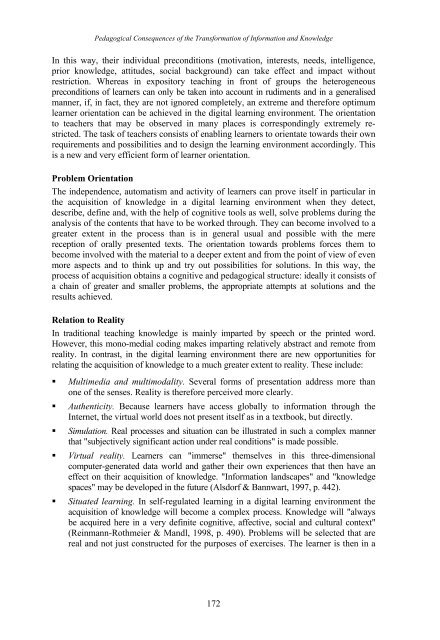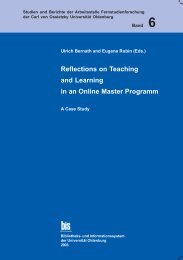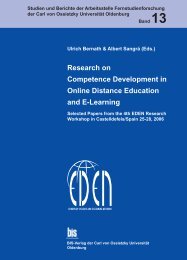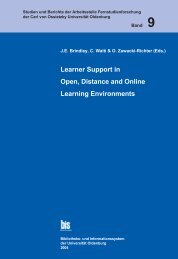Distance Education in Transition - Master of Distance Education ...
Distance Education in Transition - Master of Distance Education ...
Distance Education in Transition - Master of Distance Education ...
Create successful ePaper yourself
Turn your PDF publications into a flip-book with our unique Google optimized e-Paper software.
Pedagogical Consequences <strong>of</strong> the Transformation <strong>of</strong> Information and Knowledge<br />
In this way, their <strong>in</strong>dividual preconditions (motivation, <strong>in</strong>terests, needs, <strong>in</strong>telligence,<br />
prior knowledge, attitudes, social background) can take effect and impact without<br />
restriction. Whereas <strong>in</strong> expository teach<strong>in</strong>g <strong>in</strong> front <strong>of</strong> groups the heterogeneous<br />
preconditions <strong>of</strong> learners can only be taken <strong>in</strong>to account <strong>in</strong> rudiments and <strong>in</strong> a generalised<br />
manner, if, <strong>in</strong> fact, they are not ignored completely, an extreme and therefore optimum<br />
learner orientation can be achieved <strong>in</strong> the digital learn<strong>in</strong>g environment. The orientation<br />
to teachers that may be observed <strong>in</strong> many places is correspond<strong>in</strong>gly extremely restricted.<br />
The task <strong>of</strong> teachers consists <strong>of</strong> enabl<strong>in</strong>g learners to orientate towards their own<br />
requirements and possibilities and to design the learn<strong>in</strong>g environment accord<strong>in</strong>gly. This<br />
is a new and very efficient form <strong>of</strong> learner orientation.<br />
Problem Orientation<br />
The <strong>in</strong>dependence, automatism and activity <strong>of</strong> learners can prove itself <strong>in</strong> particular <strong>in</strong><br />
the acquisition <strong>of</strong> knowledge <strong>in</strong> a digital learn<strong>in</strong>g environment when they detect,<br />
describe, def<strong>in</strong>e and, with the help <strong>of</strong> cognitive tools as well, solve problems dur<strong>in</strong>g the<br />
analysis <strong>of</strong> the contents that have to be worked through. They can become <strong>in</strong>volved to a<br />
greater extent <strong>in</strong> the process than is <strong>in</strong> general usual and possible with the mere<br />
reception <strong>of</strong> orally presented texts. The orientation towards problems forces them to<br />
become <strong>in</strong>volved with the material to a deeper extent and from the po<strong>in</strong>t <strong>of</strong> view <strong>of</strong> even<br />
more aspects and to th<strong>in</strong>k up and try out possibilities for solutions. In this way, the<br />
process <strong>of</strong> acquisition obta<strong>in</strong>s a cognitive and pedagogical structure: ideally it consists <strong>of</strong><br />
a cha<strong>in</strong> <strong>of</strong> greater and smaller problems, the appropriate attempts at solutions and the<br />
results achieved.<br />
Relation to Reality<br />
In traditional teach<strong>in</strong>g knowledge is ma<strong>in</strong>ly imparted by speech or the pr<strong>in</strong>ted word.<br />
However, this mono-medial cod<strong>in</strong>g makes impart<strong>in</strong>g relatively abstract and remote from<br />
reality. In contrast, <strong>in</strong> the digital learn<strong>in</strong>g environment there are new opportunities for<br />
relat<strong>in</strong>g the acquisition <strong>of</strong> knowledge to a much greater extent to reality. These <strong>in</strong>clude:<br />
� Multimedia and multimodality. Several forms <strong>of</strong> presentation address more than<br />
one <strong>of</strong> the senses. Reality is therefore perceived more clearly.<br />
� Authenticity. Because learners have access globally to <strong>in</strong>formation through the<br />
Internet, the virtual world does not present itself as <strong>in</strong> a textbook, but directly.<br />
� Simulation. Real processes and situation can be illustrated <strong>in</strong> such a complex manner<br />
that "subjectively significant action under real conditions" is made possible.<br />
� Virtual reality. Learners can "immerse" themselves <strong>in</strong> this three-dimensional<br />
computer-generated data world and gather their own experiences that then have an<br />
effect on their acquisition <strong>of</strong> knowledge. "Information landscapes" and "knowledge<br />
spaces" may be developed <strong>in</strong> the future (Alsdorf & Bannwart, 1997, p. 442).<br />
� Situated learn<strong>in</strong>g. In self-regulated learn<strong>in</strong>g <strong>in</strong> a digital learn<strong>in</strong>g environment the<br />
acquisition <strong>of</strong> knowledge will become a complex process. Knowledge will "always<br />
be acquired here <strong>in</strong> a very def<strong>in</strong>ite cognitive, affective, social and cultural context"<br />
(Re<strong>in</strong>mann-Rothmeier & Mandl, 1998, p. 490). Problems will be selected that are<br />
real and not just constructed for the purposes <strong>of</strong> exercises. The learner is then <strong>in</strong> a<br />
172





